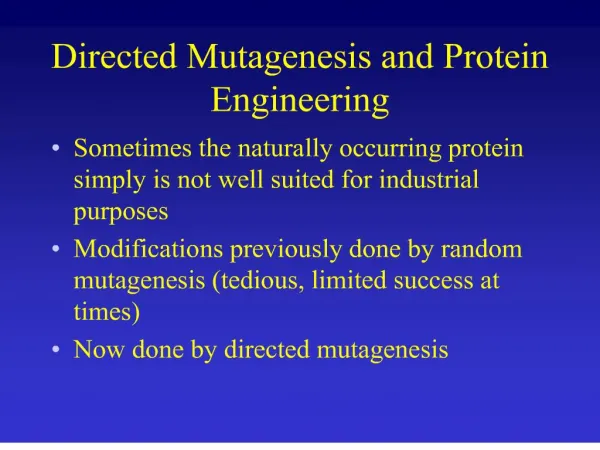Site Directed Mutagenesis
Site Directed Mutagenesis. What Is a Mutation?. What Is a Mutation?. What Is a Mutation?.
Share Presentation
Embed Code
Link
Download Presentation

hagen + Follow
Download Presentation
Site Directed Mutagenesis
An Image/Link below is provided (as is) to download presentation Download Policy: Content on the Website is provided to you AS IS for your information and personal use and may not be sold / licensed / shared on other websites without getting consent from its author. Content is provided to you AS IS for your information and personal use only. Download presentation by click this link. While downloading, if for some reason you are not able to download a presentation, the publisher may have deleted the file from their server. During download, if you can't get a presentation, the file might be deleted by the publisher.
Presentation Transcript
- Site Directed Mutagenesis
- What Is a Mutation? What Is a Mutation? What Is a Mutation? • Genetic information is encoded by the sequence of the nucleotide bases in DNA of the gene. The four nucleotides are: adenine (A), thymine (T), guanine (G), and cytosine (C), a mutation is a change in the order of these nucleotides. • A change in the order can cause the gene to encode for wrong proteins and inhibit the function of the gene or cause the gene to be virtually inactive. • Genetic information is encoded by the sequence of the nucleotide bases in DNA of the gene. The four nucleotides are: adenine (A), thymine (T), guanine (G), and cytosine (C), a mutation is a change in the order of these nucleotides. • A change in the order can cause the gene to encode for wrong proteins and inhibit the function of the gene or cause the gene to be virtually inactive. • Genetic information is encoded by the sequence of the nucleotide bases in DNA of the gene. The four nucleotides are: adenine (A), thymine (T), guanine (G), and cytosine (C), a mutation is a change in the order of these nucleotides. • A change in the order can cause the gene to encode for wrong proteins and inhibit the function of the gene or cause the gene to be virtually inactive.
- Random mutagenesis • -> based on the process of natural evolution • - NO structural information required • NO understanding of the mechanism required • General Procedure: • Generation of genetic diversity • Random mutagenesis • Identification of successful variants • Screening and seletion
- Site-directed Mutagenesis Site Directed Mutagenesis is a molecular biology technique in which a mutation is created at a defined site in a DNA molecule known as a plasmid. Wild-type gene sequence must be known. Or Site Directed Mutagenesis is a powerful technique where site specific changes in DNA sequence are produced in vitro-for instance to change an amino acid residue into another by changing the codon sequence within the gene sequence.
- CAG GTC CGG Val CAG GCC GCC CAG Thr GCC CAG GTC CAG Site-directed mutagenesis Wild type (5) translation (1) Wild type protein + primer Mutant (2) primer translation (6) + polymerase (3) Mutant protein (4) Only one amino acid changed replication Val → Thr Smith (1993)
- Genetics Mutant phenotype Mutant allele DNA sequence Protein sequence
- Why Site directed mutagenesis -> site-directed mutagenesis -> point mutations in particular known area result -> library of wild-type and mutated DNA (site-specific) not really a library -> just 2 species -> random mutagenesis -> point mutations in all areas within DNA of interest result -> library of wild-type and mutated DNA (random) a real library -> many variants -> screening . if methods efficient -> mostly mutated DNA
- INVENTION Site Directed Mutagenesis using oligonucleotide was first described in 1978 by Michael Smith & shared Nobel Prize in chemistry in October 1993 with Kary B. Mullis who developed the PCR technique. Site –directed mutagenesis Requirements: ->Knowledge of sequence and preferable Structure (active site,….) ->Understanding of mechanism (knowledge about structure – function relationship)
- Site Directed Mutagenesis • Cassette mutagenesis • Oligonucleotide directed mutagenesis • Using M13 DNA OR • Using Plasmid DNA 3. PCR amplified Oligonucleotide directed mutagenesis 4. Random mutagenesis • With Degenerate Oligonucleotide primers or • Using Nucleotide Analogues
- CASSETTE MUTAGENESIS • Cleavage by a Restriction Enzyme (RE) at a particular site in the plasmid. • Ligation of an Oligonucleotide containing Mutation in the gene of interest to the plasmid. • RE that cuts at the plasmid and Oligonucleotide is same, permitting sticky ends of the plasmid & inserts to ligate to one another.
- Site-directed mutagenesis methods – Oligonucleotide - directed method Oligonucleotides are… • Synthetic single-stranded fragments of DNA used for priming the mutated clones. • In order to work, the primers must meet the following criteria: • -must contain desired mutation. • -mutation should be in the middle of the primer. • -the GC content should be at a minimum of 40% and should terminate in one or more of C or G bases.
- Oligonucleotide directed mutagenesis • Basic Methods • 1. Base pair substitution: Change of one nucleotide (A-> C) • 2. Insertion: Gaining one additional nucleotide • 3. Deletion: Loss of one nucleotide

directed mutagenesis and protein engineering
Examples of Properties Altered for Improved Therapeutic or Industrial Applications. Michaelis constant (Km), Vmax, catalytic rate constant (kcat)Thermal tolerance, pH stabilityReactivity in nonaqueous solventsEliminate cofactor requirementAlter substrate binding site/specificityIncrease protease resistanceAlter allosteric regulation.
1.92k views • 36 slides



